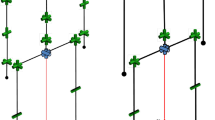Abstract
The ability to move one’s body from sitting to standing is a crucial ability for independent living. Especially for seniors with decreasing muscular strength, sit-to-stand (STS) transitions are exceptionally risky and often call for assistance. In general, an STS transition is a complex full-body activity that requires the synergistic coordination of the upper and lower limbs and trunk. An exoskeleton can support this multiple degrees-of-freedom problem by controlling the trajectory of the center of mass of the resulting human–robot system. However, while human movement is highly variable, exoskeletons usually only support one of multiple possible solutions. In this paper, we first present an analysis of factors that affect human center of mass trajectory and show that different human movement velocity profiles during STS transitions require different control strategies of the center of mass. Therefore, we propose a model based on horizontal and vertical momentums that enables efficient planning of the center of mass trajectory for any STS transition velocity. Finally, we validate this model by presenting an inverse kinematics solution for the CoM to joint angle problem using a deep Long Short-Term Memory (LSTM) network.












Similar content being viewed by others
References
Anam, K., Al-Jumaily, A.A.: Active exoskeleton control systems: state of the art. Proc. Eng. 41, 988–994 (2012)
Bengio, Y.: Practical recommendations for gradient-based training of deep architectures in neural networks: tricks of the trade, pp. 437–478. Springer, Berlin, Heidelberg (2012)
Burns, A., Lawlor, B., Craig, S.: Rating scales in old age psychiatry. Br. J. Psychiatry 180, 161–167 (2002)
Chollet, F., et al.: Keras. GitHub (2015)
Datteri, E.: Predicting the long-term effects of human-robot interaction: a reflection on responsibility in medical robotics. Sci. Eng. Ethics 19(1), 139–160 (2013)
de Leva, P.: Adjustments to Zatsiorsky-Seluyanov’s segment inertia parameters. J. Biomech. 29(9), 1223–1230 (1996)
de Rezende, L.F.M., Rey-López, J.P., Matsudo, V.K.R., do Carmo Luiz, O.: Sedentary behavior and health outcomes among older adults: a systematic review. BMC Public Health 14, 333 (2014)
Dehlin, O., Hedenrud, B., Horal, J.: Back symptoms in nursing aides in a geriatric hospital. An interview study with special reference to the incidence of low-back symptoms. Scand. J. Rehabil. Med. 8(2), 47–53 (1976)
Fattah, A., Agrawal, S.K., Catlin, G., Hamnett, J.: Design of a passive gravity-balanced assistive device for sit-to-stand tasks. J. Mech. Des. 128(5), 1122 (2006)
Fujimura, T., Yasuda, N., Ohara, H.: Work-related factors of low back pain among nursing aides in nursing homes for the elderly. Sangyo Eiseigaku Zasshi 37(2), 89–98 (1995)
Gunasekara, J.M.P., Gopura, R.A.R.C., Jayawardane, T.S.S., Lalitharathne, S.W.H.M.T.D.: Control methodologies for upper limb exoskeleton robots. In: 2012 IEEE/SICE International Symposium on System Integration (SII), 2012, pp. 19–24
Kadaba, M.P., Ramakrishnan, H.K., Wootten, M.E.: Measurement of lower extremity kinematics during level walking. J. Orthop. Res. 8(3), 383–392 (1990)
Karpathy, A.: The unreasonable effectiveness of recurrent neural networks. Andrej Karpathy blog
Kazerooni, H.: Exoskeletons for human performance augmentation. In: Siciliano, B., Khatib, O. (eds.) Springer Handbook of Robotics. Springer, Berlin (2008)
Kingma, D.P., Ba,J.: Adam: a method for stochastic optimization. In: 3rd International Conference for Learning Representations, San Diego, 2015 (2014). http://arXiv:1412.6980 [cs])
Latash, M.L., Scholz, J.P., Schöner, G.: Toward a new theory of motor synergies. Mot. Control 11(3), 276–308 (2007)
Latash, M.L., Levin, M.F., Scholz, J.P., Schöner, G.: Motor control theories and their applications. Medicina (Kaunas) 46(6), 382–392 (2010)
Lummel, R.C.V., et al.: Automated approach for quantifying the repeated sit-to-stand using one body fixed sensor in young and older adults. Gait Posture 38(1), 153–156 (2013)
Mistry, M., Murai, A., Yamane, K., Hodgins, J.: Sit-to-stand task on a humanoid robot from human demonstration. In: 2010 10th IEEE-RAS International Conference on Humanoid Robots, pp. 218–223 (2010)
Olah, C.: Understanding LSTM Networks. Colah’s Bolg
Pai, Y.-C., Patton, J.: Center of mass velocity-position predictions for balance control. J. Biomech> 30(4), 347–354 (1997)
Pai, Y.C., Rogers, M.W.: Control of body mass transfer as a function of speed of ascent in sit-to-stand. Med. Sci. Sports Exerc. 22(3), 378–384 (1990)
Pai, Y.-C., Naughton, B., Chang, R., Rogers, M.: Control of body centre of mass momentum during sit-to-stand among young and elderly adults. Gait Posture 2(2), 109–116 (1994)
Reinhart, R.F., Steil, J.J.: Reaching movement generation with a recurrent neural network based on learning inverse kinematics for the humanoid robot iCub. In: 2009 9th IEEE-RAS International Conference on Humanoid Robots, pp. 323–330 (2009)
Reisman, D.S., Scholz, J.P., Schöner, G.: Coordination underlying the control of whole body momentum during sit-to-stand. Gait Posture 15(1), 45–55 (2002)
Roebroeck, M.E., Doorenbosch, C.A.M., Harlaar, J., Jacobs, R., Lankhorst, G.J.: Biomechanics and muscular activity during sit-to-stand transfer. Clin. Biomech. 9(4), 235–244 (1994)
Schenkman, M., Berger, R.A., Riley, P.O., Mann, R.W., Hodge, W.A.: Whole-body movements during rising to standing from sitting. Phys. Therapy 70(10), 638–648 (1990). (discussion 648–51)
Scholz, J.P., Schöner, G.: The uncontrolled manifold concept: identifying control variables for a functional task. Exp. Brain Res. 126(3), 289–306 (1999)
Sikiru, L., Hanifa, S.: Prevalence and risk factors of low back pain among nurses in a typical Nigerian hospital. Afr. Health Sci. 10(1), 26–30 (2010)
Srivastava, N., Hinton, G., Krizhevsky, A., Sutskever, I., Salakhutdinov, R.: Dropout: a simple way to prevent neural networks from overfitting. J. Mach. Learn. Res. 15, 1929–1958 (2014)
Funding
Research supported by the University of Cincinnati—Creating Our Third Century—Fund.
Author information
Authors and Affiliations
Corresponding authors
Rights and permissions
About this article
Cite this article
Patil, G., Rigoli, L., Richardson, M.J. et al. Momentum-based trajectory planning for lower-limb exoskeletons supporting sit-to-stand transitions. Int J Intell Robot Appl 2, 180–192 (2018). https://doi.org/10.1007/s41315-018-0044-z
Received:
Accepted:
Published:
Issue Date:
DOI: https://doi.org/10.1007/s41315-018-0044-z




